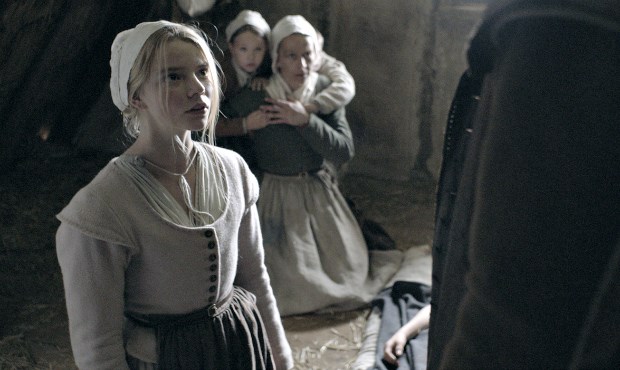We may not be much more evolved than the Puritans were, some 400 years ago. The fact that the witch is so prevalent an archetype — and sure box office draw — speaks to a deep-seeded cultural fear of female autonomy and sexuality, then and now.
Robert Eggers acknowledges this in his moody, monstrous debut feature, The Witch, which is a prequel, of sorts, for the Salem witch trials held in the 1690s. A family of seven is cast out of its rigid new-world colony after a religious dispute. Banished are the scraggly haired patriarch (Ralph Ineson), mother Katherine (Kate Dickie), eldest daughter Thomasin (Anya Taylor-Joy), the barely younger Caleb (Harvey Scrimshaw), unbiddable twins Mercy and Lucas (Ellie Grainger and Lucas Dawson) and infant Samuel.
“We will conquer this wilderness, it will not consume us,” says father, in an effort to reassure himself as much as console his family.
It is during a game of peek-a-boo that baby Samuel disappears, leaving no trace in the wide field or dark woods beyond. Thomasin, already indoctrinated and certain of her own damnation, oscillates between worry that it could be her fault and surety of her innocence. But the family suspects dark forces at work, which the film, in gruesome flashes, confirms.
“We must turn our thoughts toward God, not ourselves,” instructs father, pointing out that they’ve been blessed in not losing any of their children thus far (a nod to the infant mortality rate of the time). But mother is inconsolable: her steady diet of constant prayer is increased even more, amid worries that the infant was damned. She wishes they had never left England.
Vexed that the twins won’t do anything they’re told, Thomasin tells them that she’s a witch and will gobble them up in the night if they don’t behave, a mistruth that comes back to haunt her. Caleb may think his older sister is bewitching him, too, for he can’t stop sneaking peeks at her growing bustline.
Things go starkly downhill from there. Clearly father is neither a farmer nor an outdoorsman: he fails to shoot a rabbit (which reappears at several inopportune times at the homestead) and the meagre crops are failing. He spends any time not at prayer cutting wood with precision and no small amount of foreboding.
The twins whisper and seem to take direction from the family’s goat, Black Phillip. The devil frequently takes the form of a goat; it’s the current mascot for the Satanic Church. After a trip to the woods, someone returns possessed. Mother is going off the deep end and resentful of her nubile daughter. “I have raised up no witch in this house!” shouts the father, again more to reassure himself than anyone. Clearly there is more than one witch candidate in this family.
The banishment and the severe isolation would be fodder enough for a horror film (it’s like The Shining set a few centuries earlier). Add to that certain starvation, the infant mortality rate of the time, fear of animals and attack by native tribes, Thomasin’s sure and assumed-sinful transition into womanhood and religious zealotry: is it any wonder the family spirals out of control?
The casting call for animals to appear in the film must’ve been a fun affair: Eggers has found the most demonic-looking goat and hare imaginable.
Plus there is verisimilitude in the costuming, and spare, confining set design; the relatively trim 93-minute film uses dialogue “from period sources” and appears to use mostly natural lighting from its Northern Ontario locale to set the gloomy mood.
Characters in the film pray for mercy and for grace, but neither is afforded to the audience, treated to a steady, mostly atmospheric fear which is then punctuated by shocking brutality.
Eggers has crafted a clever horror film about malleable souls in a starved landscape, where a taste of butter could be enticement enough to go over to the dark side.
The Witch opens Thursday at Scotiabank.



